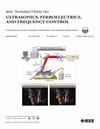机器学习增强的头骨-通用声学全息图在不同啮齿动物头骨上的有效经颅超声神经调节
IF 3
2区 工程技术
Q1 ACOUSTICS
IEEE transactions on ultrasonics, ferroelectrics, and frequency control
Pub Date : 2024-12-02
DOI:10.1109/TUFFC.2024.3506913
引用次数: 0
摘要
超声神经调节(UNM)由于其非侵入性、精确性和深度脑刺激能力而引起了脑科学的极大兴趣。然而,颅骨沿着声路径提出了挑战,导致波束失真,需要有效的声像差校正。与单元件超声换能器一起使用的声全息图通过实现像差校正和多焦刺激提供了一个很有前途的解决方案。然而,一个主要的限制是,为特定头骨设计的全息透镜可能在其他头骨上表现不佳,需要多个定制透镜进行大规模研究。为了解决这个问题,我们介绍了头骨通用声学全息图(SUAH),它可以有效地跨各种头骨类型进行经颅超声成像。我们的全息图生成框架集成了基于物理的声学全息图、异质介质中的可微声学模拟和梯度积累技术。在一系列啮齿动物头骨形状的训练中,SUAH表现出了显著的通用性和稳健性,甚至优于头骨特异性声学全息图(SSAH)。通过综合分析,我们发现即使在较小的数据集上训练,SUAH也表现得非常好,显著优于基于单个头骨的训练。总之,SUAH有望成为一种可扩展的、通用的、精确的新医学工具,与传统的单颅骨全息透镜相比,它代表着重大的进步。它能够适应不同的头骨类型,而不需要多个定制镜片,这有可能极大地促进新墨西哥大学的研究。本文章由计算机程序翻译,如有差异,请以英文原文为准。
Machine Learning-Enhanced Skull-Universal Acoustic Hologram for Efficient Transcranial Ultrasound Neuromodulation Across Varied Rodent Skulls
Ultrasound neuromodulation (UNM) has gained significant interest in brain science due to its noninvasive nature, precision, and deep brain stimulation capabilities. However, the skull poses challenges along the acoustic path, leading to beam distortion and necessitating effective acoustic aberration correction. Acoustic holograms used with single-element ultrasound transducers offer a promising solution by enabling both aberration correction and multifocal stimulation. A major limitation, however, is that hologram lenses designed for specific skulls may not perform well on other skulls, requiring multiple custom lenses for scaled studies. To address this, we introduce the skull-universal acoustic hologram (SUAH), which enables efficient transcranial UNM across various skull types. Our hologram generation framework integrates a physics-based acoustic hologram, differentiable acoustic simulation in heterogeneous media, and a gradient accumulation technique. SUAH, trained on a range of rodent skull shapes, demonstrated remarkable generalizability and robustness, even outperforming the skull-specific acoustic hologram (SSAH). Through comprehensive analyses, we showed that SUAH performs exceptionally well—even when trained on smaller datasets—significantly outperforming training based on individual skulls. In conclusion, SUAH shows promise as a scalable, versatile, and accurate tool for UNM, representing a significant advancement over conventional single-skull hologram lenses. Its ability to adapt to different skull types without the need for multiple custom lenses has the potential to greatly facilitate research in UNM.
求助全文
通过发布文献求助,成功后即可免费获取论文全文。
去求助
来源期刊
CiteScore
7.70
自引率
16.70%
发文量
583
审稿时长
4.5 months
期刊介绍:
IEEE Transactions on Ultrasonics, Ferroelectrics and Frequency Control includes the theory, technology, materials, and applications relating to: (1) the generation, transmission, and detection of ultrasonic waves and related phenomena; (2) medical ultrasound, including hyperthermia, bioeffects, tissue characterization and imaging; (3) ferroelectric, piezoelectric, and piezomagnetic materials, including crystals, polycrystalline solids, films, polymers, and composites; (4) frequency control, timing and time distribution, including crystal oscillators and other means of classical frequency control, and atomic, molecular and laser frequency control standards. Areas of interest range from fundamental studies to the design and/or applications of devices and systems.

 求助内容:
求助内容: 应助结果提醒方式:
应助结果提醒方式:


